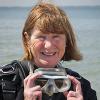
A citizen science project called Dive4Diadema wants your help to investigate the disappearance of the long-spined black sea urchin from the Mediterranean and Red Sea.
A mass extinction is taking place right now. The citizen science project Dive4Diadema is searching for the last of the diadem sea urchins in the Mediterranean and Red Sea. With your help we want to investigate the disappearance of the sea urchin Diadema setosum and document its presence or absence in these important areas.
Join us and be part of the citizen science project Dive4Diadema!
What do they look like?
Diadema setosum (Leske, 1778) has extremely long, black, hollow spines. It can be distinguished from other species by five characteristic white dots on its body. Another distinguishing feature of the species is the presence of a bright orange ring around the anal cone on the upper side of the body. However, some individuals lack the white dots or the orange anal ring (or both), although the majority have them.
Diadema setosum is a crepuscular (dawn and dusk loving) and nocturnal species that was once ubiquitous. As grazers, they restrict algal growth, clearing up space for larval settlement of other species and restraining algal proliferation that may outcompete slower growing organisms, such as corals.
Dramatic changes in the coral reefs
The disappearance has led to dramatic changes in the coral reefs and significant reduction of the entire underwater biodiversity in the respective regions. Within a short time, the colourful and species-rich coral reefs have been transformed into a reef landscape overgrown with algae and poor in species.
'Lawnmowers of the reefs'
Sea urchins are one of the most important animal groups in the coral reefs of the Red Sea. They feed on algae and are therefore the “lawnmowers” of the reefs. They contain the spread of algae and thus create space for the settlement of beneficial larvae and slower-growing organisms, such as corals, mussels and bryozoans.
Sea urchins graze on algae removing them from solid surfaces. This feeding activity leads to a strong bioerosion of the substrate that aids the development of other organisms. Particularly industrious are diadem sea urchins. As a group, diadem sea urchins consist of nine species found worldwide in warmer seas. In the Caribbean the diadem sea urchin Diadema antillarum scrapes up to 9.7 kg of calcareous sediment per square meter of coral reef every year. This creates new underwater habitats and white sandy beaches.

How to get involved
All recreational divers are encouraged to report their observations seen during their dives. There is a free, multilingual app for iPhone, iPad and Android smartphones and tablets. Every observation of live and dead diadem sea urchins helps us to learn more about the current mass mortality. Even if no sea urchins are seen on the dive, this is important information to report. Dive4Diadema is a joint effort of recreational divers, dive centres, tour operators training organizations and scientific institutions. Only together can we manage to find and save the last occurrences of the black, long-spined diadem sea urchin.
Join Dive4Diadema! Visit Dive4diadema.org and find out more.
Join BSAC and get involved in research expeditions and conservation projects - find your local BSAC club or join BSAC online today.
If you need help finding a club please email info@bsac.com and we'll send you your three nearest scuba clubs. Or if you fancy a chat call us 0151 350 6200 (Mon-Fri, 9am-5:30pm).

 Author: Jane Maddocks | Posted 05 Oct 2023
Author: Jane Maddocks | Posted 05 Oct 2023



